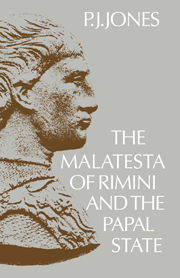Book contents
- Frontmatter
- Contents
- Dedication
- Preface
- Abbreviations
- Map of Romagna and the Marche in the later Middle Ages
- 1 The Papal State and Romagna in the thirteenth century
- 2 Rimini and the rise of the Malatesta
- 3 From commune to papal vicariate
- 4 Galeotto Malatesta, ‘ecclesie pugil’
- 5 The prime of Malatesta rule: Carlo Malatesta
- 6 The pontificate of Martin V
- 7 Sigismondo Pandolfo Malatesta, ‘fex Italiae’
- 8 The papal reconquest
- 9 The government of the Malatesta: I. The papal vicariate
- 10 The government of the Malatesta: II. The signoria
- Appendix
- Bibliography
- Index
7 - Sigismondo Pandolfo Malatesta, ‘fex Italiae’
Published online by Cambridge University Press: 23 December 2009
- Frontmatter
- Contents
- Dedication
- Preface
- Abbreviations
- Map of Romagna and the Marche in the later Middle Ages
- 1 The Papal State and Romagna in the thirteenth century
- 2 Rimini and the rise of the Malatesta
- 3 From commune to papal vicariate
- 4 Galeotto Malatesta, ‘ecclesie pugil’
- 5 The prime of Malatesta rule: Carlo Malatesta
- 6 The pontificate of Martin V
- 7 Sigismondo Pandolfo Malatesta, ‘fex Italiae’
- 8 The papal reconquest
- 9 The government of the Malatesta: I. The papal vicariate
- 10 The government of the Malatesta: II. The signoria
- Appendix
- Bibliography
- Index
Summary
Sigismondo Malatesta is one of history's reprobates, a man burdened for centuries with the character of moral outcast. According to Jacob Burckhardt, ‘unscrupulousness, impiety, military skill and high culture have been seldom so combined in one individual as in Sigismondo Malatesta’. Similarly, for J. A. Symonds, Sigismondo embodied the ‘true type of the princes who united a romantic zeal for culture with the vices of barbarians’: in his personal conduct ‘a mere savage’, in his patronage of art and letters ‘a Neo-Pagan’, in his career as condottiere ‘the most accomplished villain of his age’. It is the traditional judgement, maintained through generations by all but devout historians of the Malatesta dynasty. And even these, from an early stage, have had their reservations.
Modern opinion is more circumspect. It is now understood that Sigismondo Malatesta, like other bad characters of the past, owes much of his evil reputation to hostile testimony, and especially, as often in the Middle Ages, the testimony of the church. The worst allegations against him were all transmitted to posterity by one authority: the Piccolimini pope Pius II, whose interests as ruler, and possibly as Sienese, envenomed him against the Malatesta, and whose published anathemas and, still more, his widely read historical Commentaries, represented Sigismondo with medieval gusto and indiscriminacy as a monster guilty of every possible public and private outrage. Many of these charges can be dismissed at once as the conventional invective of curia and church.
- Type
- Chapter
- Information
- The Malatesta of Rimini and the Papal State , pp. 176 - 239Publisher: Cambridge University PressPrint publication year: 1974



